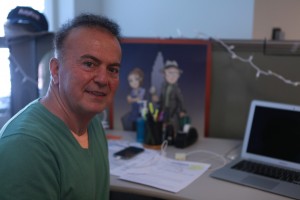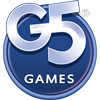Being a college student can be hard enough without adding game development to the workload. Few teams manage to pull it off. One such team is Tripleslash Studios. Meeting at the University of Utah, this ten-person team decided to work together to bring their visions to life, the first of which was Magnetic By Nature, successfully funded through Kickstarter in May.
The Beginning
The group first started out working on their senior project – to develop for Xbox Live Indie Service for the Xbox 360. But that was only the start. This team wanted to make something more than a class project, and they felt they could do that with their game’s core mechanic. “Our goal, from then on, was to take this game to a higher level of polish and bring it to as many platforms as possible for the world to see,” says Kyle Chittenden, Lead Animator and Chief Operating Officer at Tripleslash Studios. Inspired by the documentation style comments in C#, they decided to call themselves Tripleslash Studios, and hoped the sense of energy it invokes (“three waves symbolizing movement”) would show in their work.
Being in Salt Lake City, their location isn’t exactly well-known for games, but the team has not had a problem working from the capital of the Beehive State. “Salt Lake doesn’t have nearly the concentration of game developers as, say, Seattle or San Francisco, but it’s not entirely off the map, either,” explains Paige Ashlynn, CEO of Tripleslash Studios. “The founder of Atari graduated from our university, and there has been a strong local game development presence here ever since.” Salt Lake City is also home to other studios, such as CHAIR Entertainment, Smart Bomb Interactive, and NinjaBee, with which Tripleslash Studios has associated with before. “We’ve been very fortunate to interact with developers from those teams, and we hope that our efforts, like theirs, will help the gaming industry not just locally but globally,” says Ashlynn.
Learning to be a Studio
Even though location was not a problem for them, they did have their fair share of challenges. Along with problems common to new studios (“miscommunications between team members, selecting less-than-ideal technology, holding on to ideas that proved too difficult to implement by deadline, and more,” according to Ashlynn), they also came across a few technical issues. “For instance, one of the libraries we made use of while developing the XNA game had been abandoned by its authors some years ago,” says Ashlynn. “We figured, ‘Hey, it’s open source, we can figure out how it works and make changes if need be!’ In the end, we made it work, but we would have been much better off picking a current technology with an active user community who we could have asked questions and traded ideas with.”
They also had to deal with learning about marketing and business. Luckily, they had good support. “This could have been much worse for us than it was though; we were very fortunate to have seasoned game publishers, reviewers, and developers to take questions to, both at school and in the local community,” says Chittenden. “Kurtis Constantine from Red Thread Games was especially supportive, and we wouldn’t be where we are without his incredible advice.”
As both students of various stages and game developers, there was a need to manage time wisely. “In addition to developing Magnetic By Nature, many of our members were taking classes, working jobs outside of school, and raising families, so it’s been intense for all of us,” says Chittenden. So how did they preserve? Why do it at all? Both questions have the same answer: their love of the game. “Probably the biggest reason we got through it without losing our minds was because we all love creating this game together,” says Chittenden. “It was a passion project from the start, so even though we had to make sacrifices, working on Magnetic By Nature always felt fun.”
Magnetic By Nature
Magnetic By Nature is the story of a robot lost underground attempting to reactivate his friends after they were mysteriously deactivated. By manipulating magnets, the player can guide the robot through the terrain and help him reach his destination.
The inspiration of the game came from a multitude of sources, such as Mistborn and games based off magnetism, according to Jonathan Humphries, Lead Designer at Tripleslash Studios. After a bit of experimentation, they felt that there was a strong gameplay mechanic in using magnets to propel through levels. “After sharing the idea with the team, it was clear that the idea had potential, and we set out to start development on the game,” says Humphries. “Since formation, we have combined all of our minds (as well as gathered feedback from the community) to refine and solidify the concept into the game you see now.”
Knowing that funds were necessary to expand the game beyond a class project, they turned their sights to Kickstarter. But that wasn’t the only benefit to going with Kickstarter. In addition to getting their name out, it also kept them moving. “We often joke that as a team we seem to work best under pressure,” says Chittenden. “Not that we’re lazy, just that our brightest achievements have so far emerged from the cauldron of a looming deadline.” After Kickstarter, they decided to keep moving forward by always keeping the next deadline, such as a conference or convention, in mind.
Starting Out and Moving Forward
Tripleslash Studios is one of many indie studios making games they love, so they have to work to stand out. One of their noticeable traits, according to Ashlynn, is their large size, which has the benefit of speeding up their production rate, but also the added benefit of diversifying the group. “We’re not developing a single person’s private art project, but instead pushing for a well-rounded product that everyone on the team can relate to and feel proud of,” says Ashlynn. “Our hope is that we’re focused enough to create experiences that feel fresh and independent, but broad enough to ensure that our titles appeal to a variety of gamers.”
The team is moving forward with Magnetic By Nature, bringing it to as many platforms as possible, and adding a few more ideas. By 2014, they want to be working on their next game, and already have a few ideas. “The only thing we can say for sure is, whatever we do next is likely to be very different from what we’re doing now,” says Ashlynn. “We don’t want to sit still!”
To keep up to date with Tripleslash Studios, like their Facebook or follow them on Twitter. To find out more information on Magnetic By Nature, or to preorder the game, check it out here and look forward to its release for PC, Mac, and Linux in the near future.








